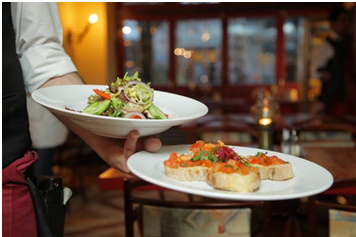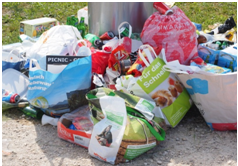Jump to Section
Introduction
A restaurant can increase profits in two ways; one way is increasing sales and the other is reducing operational cost. Thomas Keller said, “respect for food is respect for life…”.
Statistics say 31 – 40% of food wastage in America is largely caused at the consumer level. This is majorly attributed to consumer behavior and it is defined by social and economic factors.
How do you study these social factors? How can you understand the economic factors?
What Is the Connection Between Data Analytics and Food Wastage?
Peter Drucker, the management guru said: “The aim of marketing is to know and understand the customer so well the product or service fits him and sells itself…”. How can your restaurant minimize food wastage?… The answer is quite simple: Data Analytics. This does not only apply to your customer but your staff as well.
According to SAP solutions for small businesses and medium-sized companies, reducing wastage is reducing operational costs. For every dollar invested in food waste reduction, a whopping $8 is achieved.
How do I use data analytics to reduce food wastage?
You can get your customers’ details such as name, email, phone number, and address. You, however, need much more than that in data analytics. A number of which are based on observation from your staff. You should collect data such as age, food that’s ordered more often, leftovers, drink containers, religion, and any other detail you deem important.
1. Train your staff
This is the first step to acquiring any data on your customer. Focus on staff members that do the dishes and servers. They can provide great information on the kinds of food consumers don’t eat. Servers give information on orders of consumers.
2. Take note of what customers don’t eat or drink
What food is mostly left on the plate after the customer is done eating? Are there lots of leftover French fries? Or maybe lettuce?
This is speaking volumes. Reduce the volume of French fries and lettuce as the case may be. Furthermore, you can upsell or cross-sell with other food items. For instance, reduce French fries volume and add sweet potatoes for an extra fee.
3. Ethnicity/Culture
Ethnicity plays a very important role in the kind of food we eat. People from tropical regions tend to eat more spicy food and they prefer their food hot. Therefore, if you have more customers who are predominantly from the temperate region, and you stock up on chili pepper.
You’d be setting up yourself for a lot of food wastage and an increase in operating cost. If your data shows fewer customers from tropical regions, reduce the volume of spice and tropical food supplies accordingly.
4. Religion
Muslims and Christians do not eat certain kinds of meat or food. For instance, Muslims don’t eat pork. Christians may or may not eat pork. Jewish people also have certain laws by which they abide.
When getting this information, ensure you don’t come across as offensive. Get this information by creating a questionnaire so you don’t come as offensive. You can also take a guess from your customer’s name although this could be highly unreliable.
5. Age
It is very important you have the age range of your customers so that you can stock on food that suits them most. Older people tend to go for more greens and less meat.
If you serve an older population of say 50 years and above, then you can stock on those leafy greens. However, the younger generation tends to go for more meat and drinks (excluding vegetarians of course).
6. Highest Order
From your data, check the days your restaurant is busiest and take note of what’s mostly ordered, and stock up on those food items. Menus that are less ordered can be purchased in lesser quantity or stored away properly.
On your busiest days, make sure you have enough food items to satisfy every order. This means more sales and therefore more profit for your restaurant.
7. Highest Attendance
Have a way to check which waiter brings in the highest sale or attendance. This means they are doing something right. This data can be used to remunerate properly, delegate, promote that waiter, and give them more responsibility.
More sales mean more revenue and more profit.
8. Track your waste
Data analytics also include checking your waste. Go through your garbage and take an inventory of the food items, glass or plastic bottles, and other rubbish.
You need to go through the content of your rubbish for the day. With this, you will discover that some portion of the trash may be recycled. Check your menu, armed with your data, you can come up with a new menu that would resonate with your customers. Remember, Old bread makes great toast.
9. Exchange recyclable materials for cash
Used plastic bottles, glass bottles, and canned drinks can be sold to recycling companies. This gives you the opportunity to exchange your trash for cash. A simple Google search would reveal recycling companies closest to you. This can be added revenue to your restaurant. So, you’d get paid for cleaning out your trash.
10. Donate to food banks and farms:
It is important that you know that food wastage can never be eliminated, it can only be reduced. After using these 10 steps and minimizing your food wastage to its bare minimum, you can donate food that would soon turn bad to food banks and feed the poor.
Feeding America and Why Hunger readily come to mind. This can enhance tax deductions. However, it is necessary to understand the law that protects donors from liability.
Wrapping Things Up
Obtaining data from your restaurant and analyzing it can reveal so much information about your business. It is popularly said in statistics that data is more than a number – it is context.
Data analytics gives you the information you never paid attention to. This could be a major game-changer for your restaurant and save you lots of money, make you lots of money, and drastically reduce your waste by tons.
I’d say data analytics minimizes food wastage and increases profit.
- Business Intelligence Vs Data Analytics: What’s the Difference? - December 10, 2020
- Effective Ways Data Analytics Helps Improve Business Growth - July 28, 2020
- How the Automotive Industry is Benefitting From Web Scraping - July 23, 2020



